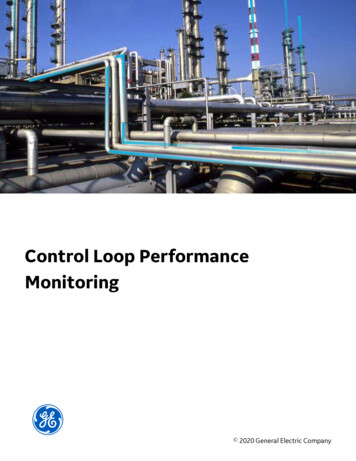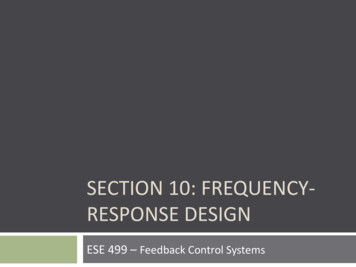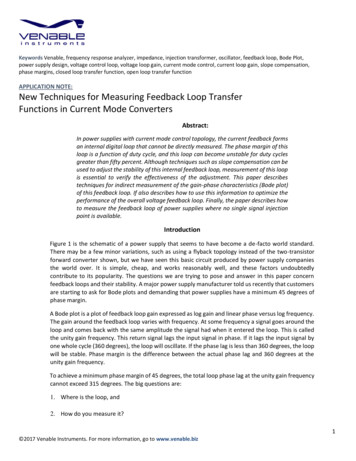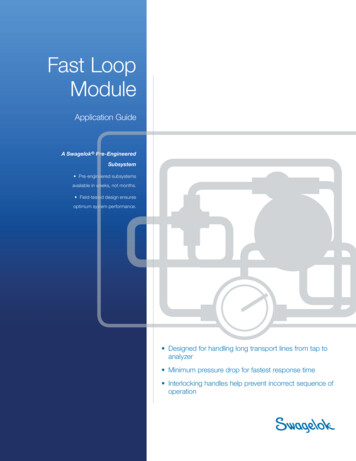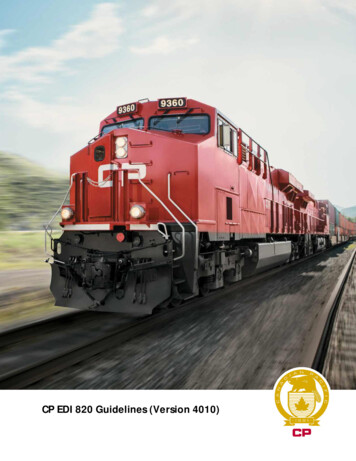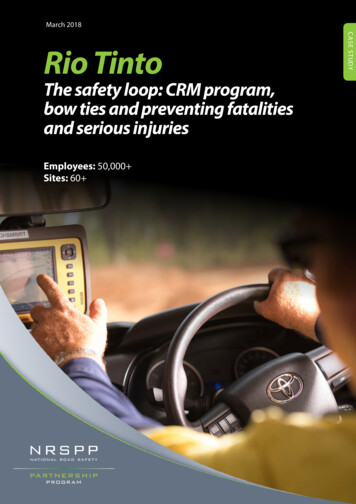
Transcription
March 2018CASE STUDYRio TintoThe safety loop: CRM program,bow ties and preventing fatalitiesand serious injuriesEmployees: 50,000 Sites: 60 NRSPPnational road safetyPARTNERSHIPprogramwww.nrspp.org.auMarch 2018 1
CASE STUDYNRSPPnational road safetyPARTNERSHIPprogramOrganisation: Rio TintoEmployees: 50,000 Sites: 60 Case Study:NRSPPnational road safetyPARTNERSHIPHow a linked CRM-bow tieapproach can prevent fatalities and serious injuriesKey Outcomes:programCreating a safety loop, that incorporates a critical risk management (CRM) program underpinnedby the bow-tie analysis method, drives perpetual improvement in safety performanceA layered verification-based CRM program helps highlight areas for improvement and engagefrontline operations in improving and maximising their own safetyThe bow-tie method can be effective in narrowing an organisation’s focus to key critical controlsthat have the most impact on safety performance on the groundImplementing a standardised system allows safety learnings to be shared globally virtuallyovernight, quickly turning safety failings into strengthsCEO-level support and cascading safety accountability via each level of management drives astrong, self-reinforcing safety cultureEmpowering frontline operational staff to stop, or not start, work if it is unsafe engages the entireworkforce in the safety process, resulting in better safety performance and improving the qualityof safety data collected to drive improvements.Synopsis:Implementing a layered critical control verification program, underpinned by the bow tie analysismethod, can create a strong safety loop that identifies weaknesses in an organisation’s frontline safetycontrols, turning them into strengths while engaging everyone from the CEO to operators in preventingand reducing serious injuries and fatalities.www.nrspp.org.auMarch 2018 2
CASE STUDYNRSPPnational road safetyPARTNERSHIPprogramOrganisation OverviewSafety StrategyNRSPPRio Tinto employs more than 50,000 people acrossthe globe – and an equivalent number of contractors– working in 35 countries and six continents.Over the past decade, Rio Tinto’s allinjury frequency rate (AIFR), a keyroadsafetymeasureof its safety performance,has reduced by about 85 per cent.nationalPioneers in mining and metals, Rio Tintohas beenin business for more than 140 years. It finds, mines,processes and markets mineral resources,All Rio Tinto workers are required to ensure thatwith a product list that includes aluminium,safety controls are in place prior to undertaking acopper, diamonds, gold, industrial minerals programtask and immediately stop the task if an uncontrolled(borates, titanium dioxide and salt), iron ore,hazard is identified.coal and uranium.In the continual tension between time, quality andThe company is strongly represented in Australia andconvenience, Rio Tinto wants its people to not feelNorth America, and also has significant businesses inrushed to complete the job, but rather be alert to theAsia, Europe, Africa and South America.hazards and empowered to stop if needed.Its Australian operations include the ArgyleRio Tinto’s safety strategy focuses on three maindiamond mine in WA’s remote East Kimberley;areas, striving to eliminate fatalities, preventthe Bell Bay aluminium smelter in Tasmania andcatastrophic events, and reduce the number andBoyne aluminium smelters near Gladstone; bauxiteseverity of injuries.mining on Cape York and in the Northern Territory;Efforts to reduce injuries include specialist programsalumina refineries in Queensland; Australia’sthat aim to improve workplace conditions, raiselongest continually operated uranium mine, Energyawareness of hazards and risks, develop a betterResources of Australia; one of the world’s largestappreciation of severity focus, and improveproducers of seaborne salt, Dampier Salt; and vastcontractor management, systems integration andiron ore operations in the Pilbara.learning from incidents.PARTNERSHIPRio Tinto’s operations are underpinned by thevalues of safety, teamwork, respect, integrity andexcellence. In regards to safety, the company aimsto foster a culture where its people keep theirsafety, and that of their workmates, contractors andcommunities, top of mind.It is committed to sharing and working with‘competitors’ to maximise safety performance acrossthe industry and believes in putting people at thecentre of its safety strategy.Strong systems, monitoring and assurance activitiesunderpin the focus on preventing catastrophicevents, which often lie outside the control ofindividual operators, such as underground risksand energy explosions.In regards to fatality elimination, Rio Tinto aimsto ensure it has effective critical controls in placethrough its layered critical control verificationprogram, referred to as CRM (critical riskmanagement), as well as recognising that there arehuman factors at play, including human error.This case study will focus primarily on Rio Tinto’scritical control verification program, developed inpartnership with Forwood Safety, with a particularemphasis on how it has tailored the popular‘bow-tie’ analysis method to identify whatfatality critical controls are required, assess theireffectiveness and create a ‘safety loop’ to ensurefailings become learnings. The case study thenfocusses on the application to vehicles and drivingas their number one fatal risk.www.nrspp.org.auMarch 2018 3
CASE STUDYNRSPPnational road safetyPARTNERSHIPprogramKicking Safety GoalsRio Tinto’s goal is for everyone to go home safe andhealthy at the end of each shift. Its approach tosafety goes beyond compliance and seeks to achievecontinual improvement. Expects every employee to be committedto their own safety and the safety of theirworkmates, and consistently set high standardsthrough their behaviour.NRSPPnational road safetyAnnually-audited global safety standards addresskey areas of risk and provide consistency in safetymanagement and performance across itsoperations and projects.The CRM JourneyRio Tinto’s layered critical control verificationPARTNERSHIPprogram covers the fatality critical risk and everyprogramoperational person, from general managers andAll levels of the organisation are expected to engagewith safety and are supported by effective fit-forpurpose management systems and internal controlsthat include monitoring and reporting against setstandards. To achieve its safety goals, Rio Tinto: Reports and investigates all incidents, ensuringlearnings are shared and implemented acrossthe organisation. Actively involves employees and contractors inall areas of safety management. Implements safety performance standards andexpectations for managing critical risks. Provides training to ensure employees andcontractors understand the controls formanaging risks. Measures and monitors performance againstminimum safety standards. Maintains an appropriate safety assuranceframework through a range of audits, reviewsand verifications against its standards. Develops, implements and embeds a focus onprocess safety and fatality prevention programs. Establishes, implements and monitors criticalcontrol plans to manage key safety risks Expects its leaders to be visible and passionatechampions for safety. They willingly acceptaccountability for the safety of everyonein their team.supervisors to operators and contractors, atevery Rio Tinto site.The company’s starting point in introducing itsCRM program was through benchmarking with theEscondida operation in Chile, where Rio Tinto is aJoint Venture partner but it is managed by BHP. BHP’sChile experience had also showed how a complexsite with a large labour force could implement andsystemise a new approach.Before roll out, Rio Tinto trialed its CRM program atthree diverse locations to test its adaptability acrossa range of operating environments, such as mining,refining and smelters, while ensuring consistencyof approach and data collection. Once the trialwas complete and the design confirmed, Rio Tintorolled out its critical control verification programrapidly across its global operations, with the speedof the roll out powered by an executive mandate,strong support from leaders and operators, and thepower of a well-designed standardised system andsupporting technology platform.www.nrspp.org.auMarch 2018 4
CASE STUDYNRSPPnational road safetyPARTNERSHIPprogramCRM Roll OutOne of the most powerful features of the CRM ishow Rio Tinto can translate a learning orimprovement to a critical control with a simplechange to a verification question. Once approved, itnational roadsafetycan happenovernight and be used around its globalThe program identified 22 core operational fatalityoperations the next day.risks, such as confined spaces, falls from heights,slope failure, contact with molten material andUnravelling the Bow-Tiecontact with electricity.programOne crucial link between Rio Tinto’s critical riskFor each risk there are a number of critical controlsmanagement program and monitoring andrequired. Those controls range from engineering tocontrolling for critical controls has been its use of theadministrative controls. Before a job goes ahead,bow-tie method.operators verify that the critical control is in place byanswering a series of yes/no questions, on aThe bow-tie method refers to a visual representationtask-by-task basis.of the risks associated with a certain hazard andthe controls that can be put in place to prevent orIn a layered process, supervisors also verify thosemitigate the risks. It takes its name from the shape ofcritical controls are in place, on a shift-by-shift basis,the diagram created, which looks like a bow-tie.and managers or superintendents routinely verifythe design and implementation of the controls.While the method was already being used acrossRio Tinto, the organisation tweaked its use ofMore than 1.4 million critical controlbow-ties to focus more on the critical controlsverifications were done in 2017 across required to address the key risks identified throughits CRM program.Rio Tinto’s global network.Rio Tinto’s CRM program was rolled out in astandardised and consistent way across morethan 60 operational sites and major projects, fromexploration and rail to marine and legacy sites.NRSPPPARTNERSHIPThe focus is on maximising the effectiveness of thecontrol and using learnings raising it in the hierarchyof controls wherever possible.Automation and technological solutions to removeemployees from the line of fire are also aconstant imperative.Having one, standardised system also allows RioTinto to have common metrics, goals and stagegates and share learnings quickly across safetyleaders and internal social media channels,such as Yammer.Taking a more structured and disciplined approach,bringing the two elements together helped Rio Tintonarrow its focus on the few critical items that wouldmake the most difference to safety at the frontline.The company challenged itself to apply a morestringent definition of what is a control and usedthe bow-tie method to ensure it was identifying theright controls and to assess whether it had specificrisks under control or whether it needed to improvethe control of a given risk.This more stringent, disciplined approach to usingbow-ties at the ‘front end’ to identify controls,and then implement layers of verification oncritical controls to ensure fatalities and injuriesare prevented or reduced, is also being used morewidely across a range of industries, including retail aswell as mining and construction. Rio Tinto also usesbow-ties for its parallel process safety program.www.nrspp.org.auMarch 2018 5
CASE STUDYNRSPPnational road safetyPARTNERSHIPprogramWhat is a critical control? An object or device, for example, a railing on the side of the road. A technical system, for example, an in-vehicle monitoring system.What is a critical control?NRSPP A direct human action, for example, a driver obeying the speed limit .that must be in place to preventor mitigate a Potentially Fatal Incident(PFI). If aroadcritical controlis not there or fails the potential for anationalsafetyfatality is greatly increased. When we are talking about what is going wrong, we are talking about what critical controls are failingor were not in place for the PFI to occur. We need to know what our critical controls are so we can checkthey are in place and effective. If the critical control is not there we don’t start the work, or if the work has already started westop and fix it now. To save a life we must say no if the control is not there to complete the task.PARTNERSHIPprogramSource: Rio Tinto Vehicles & Driving PFI presentationOn the ground outcomesHow Rio Tinto applies the bow-tie method,informed by its CRM program, on the ground can bedemonstrated by examining an internal educationcampaign it undertook about its biggest safety risk,vehicles and driving.A vehicles and driving review, completed as partof a research partnership with the University ofQueensland, revealed that almost one-third ofincidents at Rio Tinto are vehicle related. Examplesof potentially fatal incidents (PFIs) recorded includedrivers losing control of their vehicle and potentiallycolliding with an oncoming fuel tanker, vehiclerollovers, an underground vehicle driver losingcontrol down an incline shaft, and an employeebeing struck by a lift truck.Through analysing verifications completed as partof its CRM program, Rio Tinto identified three mainissues relating to vehicles and driving, with ‘driverfatigue’ and ‘road design and maintenance’ eachaccounting for about one in six incidents and ‘stopand give way at intersections’ accounting forone in 10 incidents.Rio Tinto identified that the majority of incidentstook place ‘in the pit’ (44 per cent) and ‘in and aroundthe plant’ (38 per cent); 18 per cent of vehicle relatedincidents happened ‘outside the gate’.Drilling down a step further, Rio Tinto was able toanalyse where things were going wrong andwhat critical controls were failing. In the pit, thefactors identified included segregation, or vehicleexclusion zones; road design and maintenance;operator competency, including giving way atintersections and unsecured loads; and fitness forwork, that is fatigue.Segregation was also an issue for ‘in and aroundplant’ PFIs, along with mobile equipmentmaintenance and signage and demarcation issues.Critical controls that failed most ‘outside the gate’relate to fatigue, people not following road rules,drivers not taking evasive action, and managementof loads. The data Rio Tinto reviewed to identifythese critical control failures also told it that most ofits ‘outside the gate’ PFIs related to: Vehicles running off the road Vehicle roll overs Vehicle hits vehicle Vehicle hits person/animal.Although in most cases people are not beingpermanently injured or killed, Rio Tinto recognisesthat the potential for a fatality is real.www.nrspp.org.auMarch 2018 6
CASE STUDYNRSPPnational road safetyPARTNERSHIPprogramClosing the LoopThe green controls on the right show what isworking – use of seat belts and operators being inthe moment and taking evasive action are helpingpreventfatalities. Interestingly, this examplenationalroadsafetyIn this case, Rio Tinto analysed all critical controlhighlighted that drivers not taking evasive action isfield verification data from open cut mines over ancausing PFIs but drivers who do take evasive actioneight month period and combined it with data fromare helping to prevent fatalities.all vehicle and driving incidents over a 16-monthThe learnings from this bow tie show the need forperiod. As part of the review, each individual programincreased focus on how drivers can be present andincident PFI report was read.anticipate and control these factors. The risks driversTaking a look at the resulting bow-tie diagram,themselves can control include wearing a seat belt,the red controls on the left show what is failing,speed, managing personal fatigue, and vehicledemonstrating that the highest number of PFIs arecondition (via pre-start checklists).caused by ‘human performance’, typically whereIn addition, factors Rio Tinto can control includea driver has not taking or not being able to takeensuring vehicles and in vehicle monitoring systemsevasive action to try and avoid an incident.are maintained; educating employees aroundfatigue and mental wellbeing.NRSPPApplying those findings through the bow-tiemethod (see diagram) shows visually and quicklywhat the issues are and what is working.PARTNERSHIPControl failures leading to PFI’sControls that help prevent a fatalitywhen an incident occurswww.nrspp.org.auMarch 2018 7
CASE STUDYNRSPPnational road safetyPARTNERSHIPprogramThe Safety LoopEyes on the GroundRio Tinto uses the bow-tie method as an initial toolThe combination of on-the-ground frontline checksto highlight how risk unfolds in its business andand a database that all Rio Tinto safety leadersmeasure the critical controls being used to managearound the world can access brings global datathat risk. The strength of the bow-tie approach is astogether with local action. If any Rio Tinto personelnational roadsafetythat initial identification tool, allowing companiesfinds a gap in a control, it must be fixed there andto visually represent how specific risks are beingthen. Work cannot commence or a truck cannot bemanaged and examine if they have the rightdriven until it is fixed.controls in place.General managers are ultimately responsible forprogramThe next critical step, as identified by Rio Tinto’ssafety, and that responsibility then cascades to theirapproach, is using incident data and controlmanagers. Those managers are discussing directverifications to ‘close the loop’. The critical controlswith site superintendents or supervisors key safetyidentified are tracked through the critical controlareas to be focused on in their operations.verification process, which verifies effectiveness ofSuperintendents or supervisors then share relevantthose controls in the field, and through the incidentinformation with their teams and converselyreview process.operations share with their leaders.NRSPPPARTNERSHIPThe results of this process are fed back into the CRMto validate the effectiveness of current controls toprove they are effective or to highlight the needto devise better controls. Any new controls resultin the relevant bow tie being updated, and sothe loop continues.At Rio Tinto, control verificationincludes daily physical checks inthe field by 6,500 frontlineoperational leaders.This ‘cascade effect’ reinforces a strong safety cultureand expectations within the organisation.Operators themselves are also supported andauthorised to not start work or stop work if it’s notsafe, and to seek help from leaders to ensure controlsare in place. Rio Tinto is also encouraging its peopleto ‘embrace the red’, reinforcing an attitude thatidentifying a non-conformance is a positive.These checks are recorded in a centralised globaldatabase, highlighting any non-compliances so anypotential weak areas are identified and canbe rectified. Other operational staff, like truckdrivers, also do checks before they start taskswhich may pose a fatality risk.In combination with analysing incident data to helpidentify trends, verification data highlights specificissues, allowing Rio Tinto to implement an educationcampaign or modify the verification questions it asksat the frontline to monitor its effectiveness.www.nrspp.org.auMarch 2018 8
CASE STUDYNRSPPnational road safetyPARTNERSHIPprogramResults and ImpactRio Tinto has already recorded more thanRio Tinto can analyse verifications across sites, using1 million control verifications per year since rollingGPS location signatures; times of the day; acrossout its CRM program, with more than 25,000tasks; and across the variability among operators,verifications completed across Rio Tinto’sglobalsupervisorsand general managers, to examinenationalroadsafetyoperations each week.specific risks and controls.The organisation believes it is too early in its CRMThis data allows the company to delve deeper intoimplementation to quantify results of the program,patterns, such as which controls fail or are missing,however the level of safety awareness and of criticalthe time of day or week the verifications take placeprogramcontrols at the frontline has significantly improvedand which leaders are conducting verifications.as has the targeted focus on measures needed toCorrective action can then be taken to ensure itprevent fatalities and serious injuries.has strong coverage of control verification, by sitelocation, leader, risk and job type.The CRM-bow tie safety loop has also addeddiscipline to Rio Tinto’s safety processes and thequantity of verifications has resulted in significantimprovements on the ground. Some verificationsare paper based and logged later in the shift, butincreasingly data collection is moving into real timeonline via a mobile app Rio Tinto and tied to itsreporting system.Rio Tinto’s All Injury Frequency RateRio Tinto’sAll TNERSHIP1.41.21.00.80.60.40.2Source: CRM mobile appprovided by Forwood ‘15‘16‘17www.nrspp.org.auMarch 2018 9
CASE STUDYNRSPPnational road safetyPARTNERSHIPprogramLessons and Learningsacross the organisation and contributes to a cultureRio Tinto has managed to reach the frontline andwhere Rio Tinto’s people recognise verificationengage in the safety discussion the people actuallychecklists as a tool for them to use to help keepexposed to the risk – they are the ones doingthemselves and their colleagues safe.on-the-ground checks and verifications. Thatnationalroadsafetymeans, if the process is followed, every visible andLeveraging technology makes getting datacontrollable risk is being addressed beforeinto a CRM program easier and faster and allowswork commences.organisations to keep control of system design andcontent. At Rio Tinto, technology around theIt also provides a rich data set about theprogramCRM program means using the mobile appeffectiveness of specific controls, allowing Rioto capture data.Tinto to highlight and address gaps. Collectingstandardised content also enables Rio Tinto toOrganisations need to be patient and give theirshare and mobilise learnings quickly, by updatingsafety strategy time. Large businesses can’t changeverification questions, across its global network.course easily but regardless of business size it takestime to roll out a safety strategy, embed it and getresults. The roll out may be completed in weeks ormonths, but cultural change and improvementscan take years.NRSPPPARTNERSHIPWhile capability is a consideration, Rio Tintobelieves the approach it has taken is not limitedto larger organisations; any business can take aperson-centred approach to safety that includesmultiple levels of verification to reduce and preventinjuries and fatalities.To ‘bring people with you’, it’s also important theyunderstand why a safety focus is important — toprevent fatalities and injuries — and that using astandardised model makes it easier and fasterto share learnings.Keep in mind though, Rio Tinto cautions, that whilea very important tool, initiatives like a critical controlverification program are just that – a tool. A businessstill needs to ensure it has the systems and culture inplace that supports and complements all the pillarsof its safety strategy.Rio Tinto’s experience also shows support from thetop, from the CEO down, is critical in improvingsafety. It also drove, in Rio Tinto’s case, fastimplementation of the CRM program. Suchhigh-level support creates safety engagementwww.nrspp.org.auMarch 2018 10
CASE STUDYNRSPPnational road safetyPARTNERSHIPprogramSeven Critical Control Program Tips Don’t invent — just implement. Or as the team likes to call it, adopt don’t adapt. Resistbuilding your own. Instead of building a bespoke or proprietary system, build proprietarysafety leaders and champions who can deliver it. Reduce Complexity, don’t multiplyit. The greatchallengesfor operators and leaders are thenationalroadsafetylegacy systems in place. No one wants to be seen to have dropped an old process but it isthe discipline needed during or after the rollout. Make it easier. The fundamental question to ask at every step is how will this make it easierprogramfor a night-shift operator or superintendenton a weekend with new staff or skeleton crew?How will it work in the toughest conditions and locations? So therefore: Ask the operators what is important. As an operator told us, “at least you are asking theright questions. For CRM is about binary decision making. Checking what can kill you ifyou do not have the controls in place.” Such critical risk analysis provides an opportunityfor operators to tell you what is really important. Putting verifications in the hands ofthe operator also enables a conversation about how to make tasks easier and safer. Theirsolutions will often be quick and simple to implement. Faster rollout faster learnings. Rather than rolling out CRM relatively slowly in a stagedmanner, it was done quickly group-wide. The keys were having a centralised support teamand metrics ready, enabled by technology. Interestingly, and it may seem counter-intuitive,rolling it out all at once at great pace also accelerated learning. That is because everyonewould share their experiences, their concerns and their solutions via safety leader peersand the online social media and communication tools we used. So a problem or risk orconcern in Madagascar could be shared and solved with peers in Canada thanks to thecommonality of approach. Metrics and minds. A metric report of compliance and non-compliance can tell you alot, but it can only tell you so much. The dashboard can’t really tell you as much as thequalitative value of a good toolbox talk, and it can’t necessarily tell the difference betweena verification done by the seasoned hand on Wednesday and the verification done by anapprentice working late hours on a Saturday. That is why leadership in the field is vital tohaving the informed safety conversation, recognising the human factors at play. Believe it. Senior leadership and HSE practitioners have to believe CRM works, for ifthey don’t the frontline won’t either and it will be ineffective. Strong active executivesponsorship, from the CEO down, sets the tone and provides the imperative for behavioursto change. Holding your reports accountable for the adoption and effectiveness is crucial. Ifthe CEO is asking informed questions of their reports, they will ask their general managers,who will ask their people.NRSPPPARTNERSHIPSource: Minesafe International 2017 Address, Joanne Farrell – Rio Tinto GroupExecutive Health, Safety & Environment and Managing Director Australiawww.nrspp.org.auMarch 2018 11
CRM program was through benchmarking with the Escondida operation in Chile, where Rio Tinto is a Joint Venture partner but it is managed by BHP. BHP's Chile experience had also showed how a complex site with a large labour force could implement and systemise a new approach. Before roll out, Rio Tinto trialed its CRM program at



